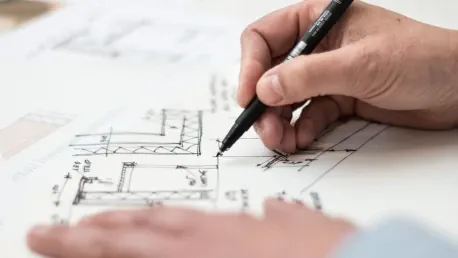In recent years, artificial intelligence has emerged as a game-changer in various industries, and the field of architecture is no exception. AI is now reshaping traditional design processes, integrating sophisticated tools to enhance efficiency, sustainability, and execution across architectural projects. This shift goes beyond the well-known capabilities of platforms like MidJourney and DALL-E, towards specialized technologies that meet specific design needs. From urban planning to building construction, AI’s integration into architecture is creating innovative solutions that prioritize functionality, sustainability, and aesthetics.
Revolutionizing Urban Design
Spacemaker stands out as a revolutionary AI tool in the realm of urban design, leveraging site-specific parameters to generate optimized layouts that maximize livability within environmental and zoning constraints. By analyzing various factors such as sunlight, noise, wind, and topography, Spacemaker allows architects to create urban spaces that are not only compliant with regulations but also conducive to a high quality of life. This AI-driven approach ensures that every element of the urban plan is meticulously thought out, thereby enhancing the overall functionality and appeal of the space.
The use of such AI tools streamlines the design process, saving time and reducing costly errors that were once prevalent in traditional planning methods. Architects can now experiment with multiple scenarios in a fraction of the time it would take using conventional techniques. This capability to simulate and evaluate various options quickly makes it possible to achieve more sustainable and efficient urban designs. Additionally, AI’s ability to process and analyze massive datasets far exceeds human capacity, enabling the creation of more accurate and effective urban plans.
Enhancing Structural Design
AI’s impact is not limited to urban planning—it also extends to the structural design of buildings. nTopology, for example, utilizes generative design principles to create complex, lightweight structures that are optimized for strength and material efficiency. Through AI algorithms, nTopology can explore innumerable design variations, assessing each one for performance, cost, and manufacturability. This results in structures that are not only innovative but also sustainable, reducing the material required and minimizing waste.
Moreover, AI-powered tools such as nTopology significantly enhance the creativity and capability of architects. These tools allow designers to push the boundaries of traditional architecture by exploring shapes and forms that would be impossible to achieve through manual design alone. This technological advancement leads to the creation of iconic buildings that are both functional and visually striking, contributing to the evolving skyline of modern cities.
Optimizing Environmental Impact
Another crucial area where AI is making significant strides is in optimizing the environmental impact of architectural projects. Ladybug Tools offers a suite of open-source plugins that simulate energy use, daylighting, and environmental impacts. These simulations provide architects with the necessary data to visualize and optimize their projects for sustainability. By incorporating Ladybug Tools into the design process, architects can ensure their buildings consume less energy, provide better indoor environmental quality, and have a smaller carbon footprint.
The capability to simulate environmental factors before construction begins is invaluable in creating buildings that are eco-friendly from the outset. Architects can assess how different design elements will affect energy consumption and make informed decisions to improve sustainability. This proactive approach not only benefits the environment but also reduces long-term operating costs for building owners.
Improving Construction Monitoring
AI is also transforming construction monitoring, making the building process more efficient and less prone to errors. HoloBuilder, for example, leverages AI and 360-degree imaging to offer immersive walkthroughs of ongoing projects. This technology allows stakeholders to monitor construction progress in real-time, facilitating better communication and problem-solving on-site. With AI, potential issues can be identified and addressed promptly, ensuring that projects stay on schedule and within budget.
Immersive technologies like those offered by HoloBuilder provide a level of detail and accuracy that was previously unattainable. This leads to better project management and higher quality outcomes. Furthermore, the ability to document and share real-time updates helps maintain transparency with clients and other stakeholders, fostering trust and collaboration.
Integrating Augmented Reality and BIM
Another fascinating development in AI’s impact on architecture is the integration of augmented reality (AR) and Building Information Modeling (BIM). Placenote, for instance, allows for the superimposition of 3D models over real-world environments, providing on-site design visualization prior to construction. This capability enables architects and clients to view and interact with the proposed design in its intended physical context, thereby improving spatial understanding and decision-making.
Additionally, technologies like ScantoBIM facilitate the conversion of physical spaces into detailed BIM models. This is particularly useful for renovation and retrofitting projects, where accurate representations of existing structures are paramount. By reducing complexities and minimizing errors in the modeling process, ScantoBIM streamlines project workflows and enhances accuracy. The ability to create precise BIM models ensures that all stakeholders have access to detailed and up-to-date information, which is crucial for efficient project execution.
Conclusion
In recent years, artificial intelligence has become a major game-changer in a variety of industries, and architecture is no exception. AI is revolutionizing traditional design processes by integrating advanced tools that improve efficiency, sustainability, and the execution of architectural projects. This transformation goes beyond the well-known capabilities of popular platforms like MidJourney and DALL-E. Instead, it involves specialized technologies tailored to specific design requirements. Whether it’s urban planning or building construction, AI’s integration into architecture is fostering innovative solutions that emphasize functionality, sustainability, and aesthetics. By automating repetitive tasks, predicting outcomes, and optimizing resources, AI is helping architects to focus more on creativity and less on mundane aspects. Moreover, AI-driven tools enable the creation of more energy-efficient and eco-friendly designs, addressing the increasing demand for sustainable solutions in modern construction. Overall, AI’s role in architecture signifies a significant shift towards more intelligent and thoughtful design practices, promising to reshape the future of our built environment.









